CSA Newsletter Week 11 (August 29 – Sept 2, 2022)
CSA Newsletter Week 11
August 29 – Sept 2, 2022 | “A” Week

The Smolenskis showed up this Monday to help bag all the CSA corn and crate it up! This is a big job that takes about 90 minutes, and really helps out our crew! Thank you!
What’s in the Box this Week?
CARROTS (with tops) ~ Remove the green tops as soon as you can, leaving about an inch of stems. Refrigerate these carrots in a plastic bag. You can also store them in a bin of water (like celery) to keep them crisp, changing out the water every few days. Save the tops in a plastic bag. To prep: Organic carrots don’t need to be peeled. Boil 2-inch cubed carrots in rapidly boiling salt water, uncovered, for 7-10 minutes. Fresh carrot tops can be chopped into a green salad or stir-fry too! The greens can be dried and used as an herb like parsley. To freeze: Blanch cut coins for 3 minutes in boiling salt water, dunk in cold ice water for 3 minutes, drain, let dry, and pack in airtight container.
GLOBE & HEIRLOOM TOMATOES (8) ~ You will receive two heirloom and 6 Golden Roma tomatoes. Heirloom tomatoes will have cracks and weird shapes to them. The golden romas would be great for making a sauce, or roasting them (to freeze later). To store: Do not refrigerate tomatoes. Store them at room temperature out of the sun stem side down. Putting them in a paper bag will accelerate the ripening process. Heirloom tomatoes will have strange shapes and cracks. They should be eaten on the first or second day, as they have a very low shelf life — but incredible flavor!!
CHERRY TOMATOES (1 pint) ~ Store these at room temperature on your counter. Wash before eating. Eat them out of hand or try roasting them.
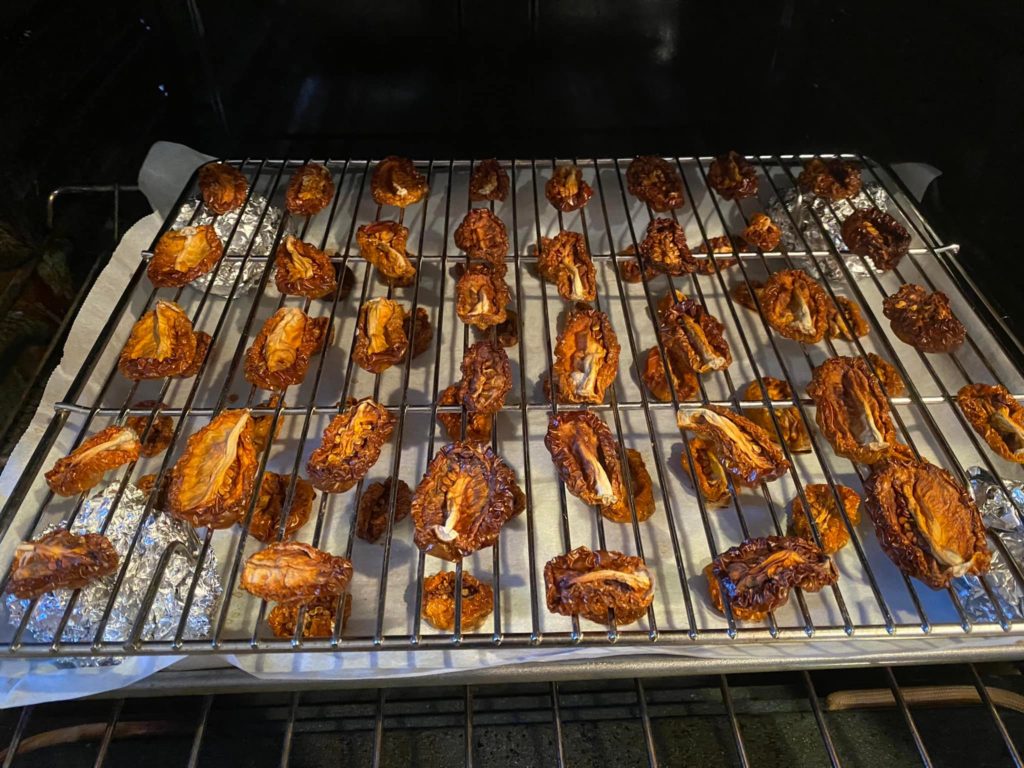
Merissa Rojas successfully roasted her golden romas in a low temperature oven.
BROCCOLI GREENS (treat this like kale) ~ Many people don’t know that the leaves of all the cole crops are edible. To store: Store greens in a Green bag in your fridge for up to 5 days to keep leaves from going limp. To prep: Rinse leaves. To remove leaf blades from stems, fold leaves in half and tear or cut the central stem away. Roughly tear or chop leaves. The stems are also edible. To use: Saute with olive oil and garlic. Add wilted greens to spaghetti sauce, quiche, pastas, or soups. Bake into chips. To freeze: Blanch leaves for 2 minutes in boiling water. Place leaves and stems in ice water. Drain. Quick-freeze small clumps of greens individually on a cookie sheet. After they’re frozen, place clumps into freezer bags in bulk. Remove as much air as possible from bags before sealing.
ORANGE/RED ITALIAN FRYING PEPPERS (4) ~ These look like they might be spicy because of their color, but they are totally sweet! Great for grilling. To store: Refrigerate peppers unwashed in a sealed plastic bag in the crisper drawer for 1-2 weeks. To prep: Cut in half and remove the seeds from the inside. Slice, chop or mince. To freeze: Wash and dry peppers. Freeze whole or cut into bite-size pieces and place in Ziplock freezer bag, removing as much air as possible.
SNACK-SIZE MINI SWEET PEPPERS (1 pint) ~ these look like mini bell peppers. They are sweet and perfect for a lunchbox treat! Refrigerate peppers unwashed in a sealed plastic bag in the crisper drawer for 1-2 weeks.To freeze: Wash and dry peppers. Freeze whole or cut into bite-size pieces and place in Ziplock freezer bag, removing as much air as possible.
EGGPLANT (1) ~ Wrap unwashed eggplant in a towel (not plastic) to absorb any moisture, and keep it in the veggie drawer of your refrigerator. Or store unrefrigerated at a cool room temperature. Use within a week and it should still be fresh and mild. To prep: Eggplant is usually peeled. The flesh will brown when exposed to air. To prevent browning, coat in lemon juice or keep submerged in water. To use: Brush 1/2-inch to 1-inch slices of eggplant with olive oil or melted butter and broil or grill until brown. It also makes an excellent baba-ganoush dip. To freeze: Peel and cut into slices 1/3-inch thick. Blanch for 2 minutes in steam. Cool immediately in cold water. Package in layers with each slice separated with two pieces of wrap.
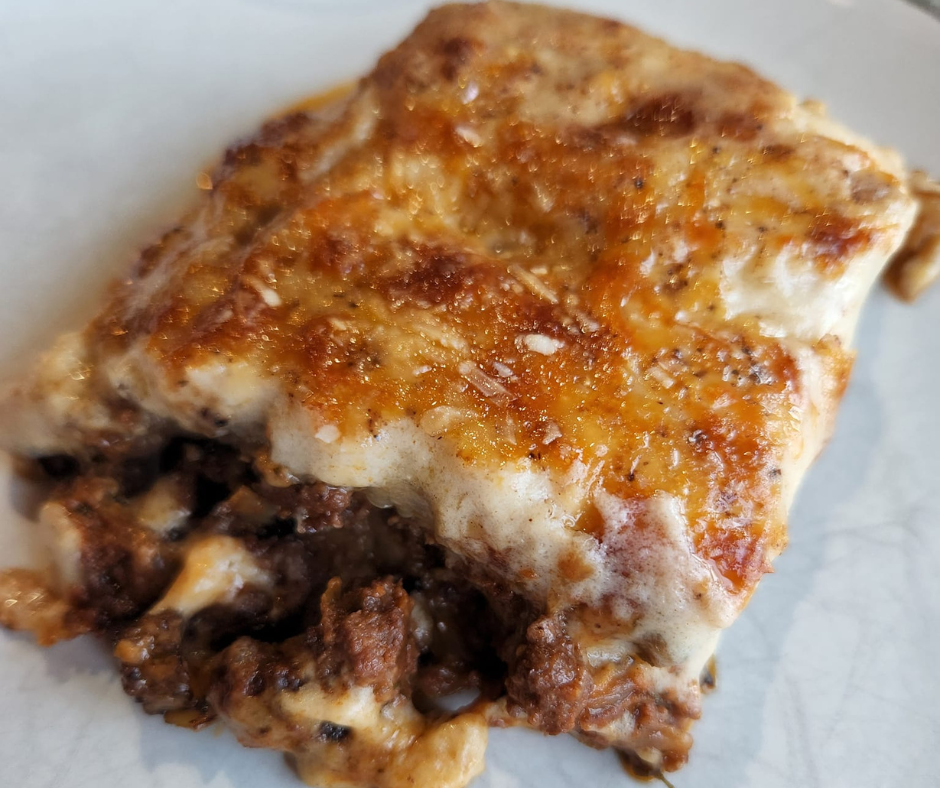
Moussaka made by Val Washeck this week using eggplant.
YELLOW ONIONS (3) ~ Store these cured onions in a cool, dark place — not the fridge. And keep them away from potatoes. You can freeze onions simply by chopping to size and then throwing them into a Ziploc bag!
SWEET CORN (6) (not organic, non-GMO) ~ To store: Refrigerate sweet corn as soon as possible with husks on. The longer you wait to eat it, the more sugar will turn into starch, and the corn will lose its \ sweetness. To prep: You can eat corn raw or cook it in the husks. Shuck the cob by pulling the husks down the ear and snapping off the stem. The silks will fall off as you cook the corn. Rinse under cold water. If you see a green worm, just cut out the damaged section — the rest of the cob is still edible! To cut the kernels off the cob, stand the cob upright on its base and run a sharp knife from the tip of the ear down to the base. To cook: Steam corn in 1-2 inches of water for 6-10 minutes, or drop ears into boiling water for 3-6 minutes. Season with butter or salt. You can also grill corn in the husk — place the corn in its husk in water for 10 minutes — then place on grill for 15 minutes. To freeze: Blanch on the cob for 3-5 minutes, rinse under cold water, and drain. Cut off the kernels with a knife, and then pack it into airtight freezer containers.
WEEK #11 ADD-ON SHARES: Week “A”
Odd-numbered weeks of our CSA season (week 1,3,5) are called “A” weeks. And even-numbered weeks (week 2,4,6) are called “B” weeks. If you have any kind of non-veggie, bi-weekly share, you have been assigned to either “A” or “B” week for the season. If you get a cheese share, it always comes on Week “A.”
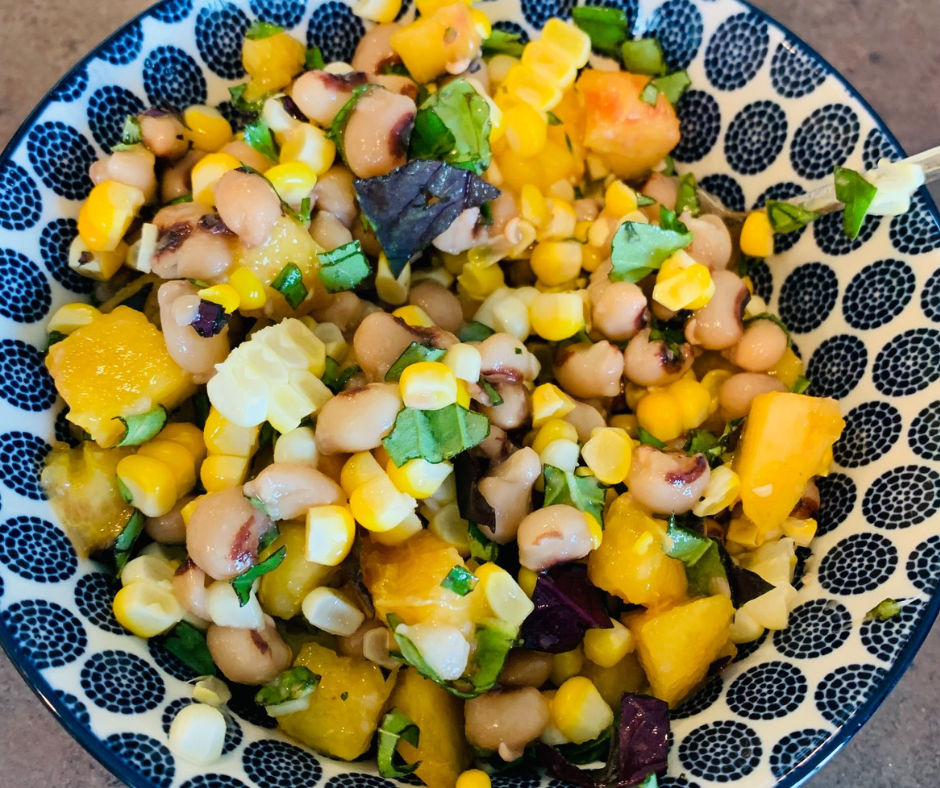
Brianne Markley made this black eyed peas, fresh corn, peaches, and basil from the garden. Topped with feta too.
WEEK 11 FRUIT SHARE:
Remember, the fruit share is a 16-week product. It will end on week 16 of our 18-week veggie CSA season.
PEACHES (Quarry Hill Orchard) ~ This will be our final week of peaches! To store: If your peaches are not yet ripe, store them out of the sunlight on the countertop until they are soft and aromatic. Once they are ripe, place them in a plastic bag in the fridge. To prep: Wash and remove the pit inside
BARTLETT PEARS (Quarry Hill Orchard) ~ Pears are picked unripe and ripen best at home off the tree. You should always purchase pears that are firm to the touch. A ripe pear will be ready at home when the skin around the neck gives to slight pressure. Note: Cut pears will turn brown when exposed to air. Coat them with lemon juice to prevent this. To store: To ripen pears, place in a loosely closed paper bag out of the fridge at room temperature until the skin responds to a gentle pressure at the neck of the fruit. After pears have ripened, store them in a plastic bag in the fridge in your crisper drawer.
CANARY MELON: (Bench Farms) These yellow-skinned melons have a lime-green super sweet inside. Store this in your fridge, and try to eat it within 5 days. Cut the melon open down the middle, and then scoop out the seeds inside.
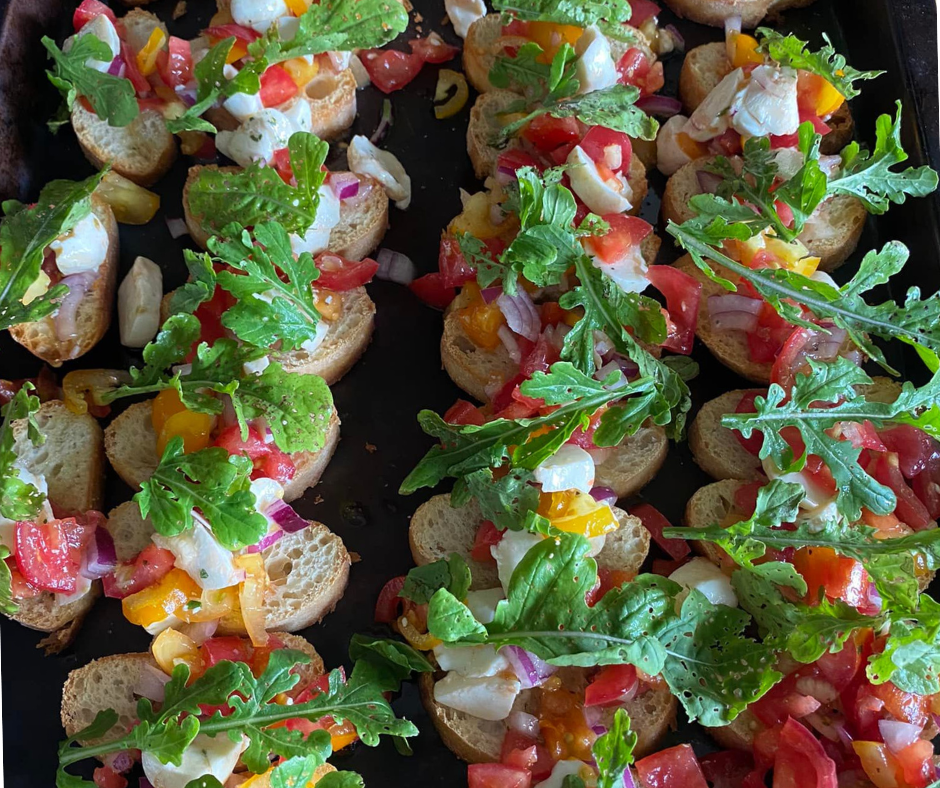
Alyssa Baker made this tomato bruschetta with arugula.
Cheese Week:
Canal Junction Farm: mmBossie Cheddar; Flat Rock
MacKenzie Creamery: Garlic Chive Chevre
Ice Cream Flavor of the Week:
Cold Brew from Knueven Creamery. Note: be sure to stop and pick up your ice cream from the Knueven milk truck at your pickup site! They will be located either right before or after your veggie pickup. Your farmers will not be passing this out in their delivery line.
Coffee Flavor of the Week:
Steel Magnolias: Maddie & Bella Coffee Company Milk chocolate/ cherry/ cinnamon ~ Women-owned!

I took my bride to a surprise Brad Paisley concert on Put-in-Bay for our anniversary this Wednesday.
FARMER KURT’S FIELD NOTES
I surprised Corinna this Wednesday with tickets to see Brad Paisley in concert at Put-in-Bay for our anniversary! She had no idea what was coming! There actually wasn’t a super huge crowd there that night — I was worried getting across the ferry would take a while. But we were able to eat some dinner and catch his 90 minute set, while sitting comfortably in our camping chair rockers. We have many fond memories of Brad Paisley from our dating years, and our boys used to race around the house singing “Mud on the Tires” and “Hey Hey Mr. Policeman.” So I really aced this one. In fact, on the ferry ride home, Brad’s tour bus pulled onto the ferry with us, and his band members actually got out and mingled with fans. I want to say a big thank you to my Wednesday crew and volunteer Clara Eckel for getting the CSA boxes packed that day without us around! This summer, thanks to my crew, I’ve been able to get away from the farm and have a life — more than in the past. And that has made a big difference on my energy level and motivation.

The garlic is laid out in crates to cure for 10 days.
We’ve started processing garlic. It’s finished curing, and so I have to cut off the bulb from the stalk, rub off the outer skin and sort by size. There are about 50 crates left to do, and so I’m wondering if you might want to come out and help me get it done this week on your own time? Please email Corinna. It would save me a whole day’s labor 4 of my crew members — and I’m over-budget right now on my labor costs. Some of these bulbs will end up in your CSA box, and some of it will turn into seed for next year’s crop. (Each clove is actually a seed!) I plant them at the end of October, around Corinna’s birthday.
Jed went back to school this week. His first week at the Aviation Academy in Toledo has been awesome. He loves going to school now. Even the drive isn’t that bad, although we are burning through a lot of gas now. I fill up the tank 3 times a week! Josiah went to his 6th grade orientation at Woodmore on Thursday, and Corinna said he didn’t want to leave the building! He found ways to linger and talk with his old teachers and friends and hang out in the library. He is such a social guy, and so I think putting him back into school will be good for him. We will be celebrating this milestone this weekend — launching our kids back into school is a big deal, and we’re really proud of them.

Polo brings in a load of bulk tomatoes.
The crew has been harvesting tomatoes and peppers every day. To meet the need for bulk tomato canners, we have filled two wagons of tomatoes! (My mom’s roadside stand sells our product, so we have to pick enough for her every day too). We pulled out the trellises from the cucumbers. I disked up a bed of beets this week. We also harvested the second block of melons. We have a TON of those big red watermelons — which you’ll see in the week 12 fruit share. There were 12 bulk bins of melons — took the crew only 2 hours.

These cucumbers are done! We removed the trellis system.
I seeded daikon radishes, another round of Red Scarlett Queen turnips (the last batch didn’t take), white turnips, and rutabaga last night with my vacuum field seeder. (Corinna calls it Frakenstein with all its weird hoses). It was a late night for me, as I worked until about midnight. Right now, although I own the seeder, I borrow the seed plates from my buddy farmer Adam in Fremont. So I had to squeeze it all in Friday night, since he needed the plates by Saturday morning. What I really need to do is just buy my own set of seed plates — would probably save me a lot of back-and-forth driving time. Just not in the budget this year.
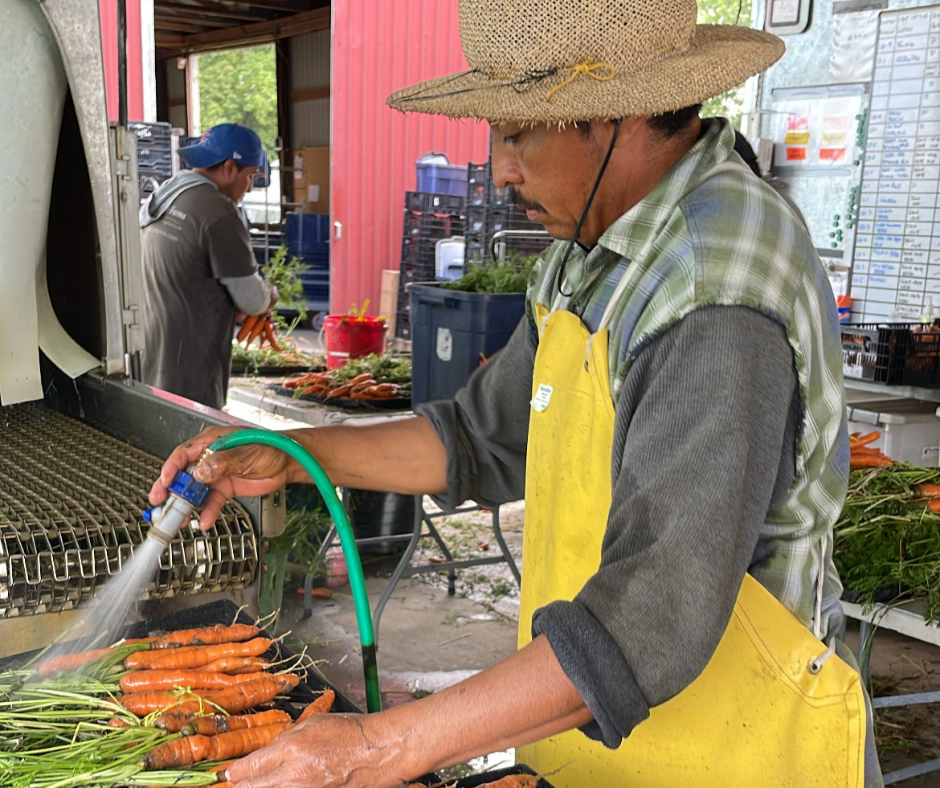
Polo washed carrots last Thursday. This was an all-day event — harvesting, washing and bundling.
My crew spent a whole day harvesting a bed of super-weedy carrots, which are going into your boxes this week. I almost didn’t make them do it — still not sure if that was a good use of labor time. It was a demoralizing job, trying to find the individual carrots one by one under the heavy crab grass.
We have a little drama brewing over here in Elmore surrounding a creek-drainage issue. Part of our farm property sits along Wolf Creek. Trees are falling into the creek, causing blockages and creating drainage problems. It now needs to be dredged to keep things flowing. To try and solve the problem, a big project has been proposed that will cost us $5000 in assessment fees. Some of the property owners are up in arms about the project’s scope and cost, and the fact that the vote is coming so suddenly. Although I agree that the creek needs to be dealt with, I’m not happy about the fact that they’re going to cut all the trees down along the creek on my property. Corinna and I will be at the Commissioner’s meeting/vote next week to voice our disapproval of the execution plan and propose an alternate solution. Not sure if it will make a difference, but I just want to make sure they’ve thought through the impact of their decision.
~Your Farmer, Kurt
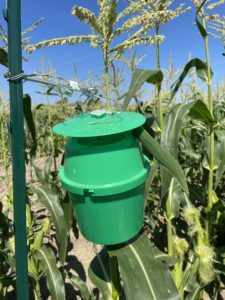
We use these traps to keep track of the number of moths that could cause damage to our crops.
Why Farmers Count Moths
We use lots of strategies for trying to control bugs on the farm. One big problem we have is worms in the corn.
If you walked through our sweet corn fields, you would occasionally see a green bucket hanging upside down. The bucket reminds me of the childhood game “Barrel of Monkeys.” These barrels are actually traps for a certain kind of moth, whose larvae attack our sweet corn. The moth lays its eggs in the silks of the sweet corn. The eggs hatch and turn into worms that feed on the tips of the corn. (Have you ever found a worm at the tip of your corn ear?)
The Ohio Extension officer comes to check our traps every week in order to determine what pests are becoming a problem locally. He literally counts the number of moths he finds in each container. (How about that for a job?) A high number means there will soon be worms in the corn, and we need to spray for worms. This information is shared with the farmer, but is also used to alert other farmers in the area of potential area pests that may infest their fields.
Worms become more and more problematic the later we get in the season. If you find one, simply cut off the bad part. The rest of the ear is perfectly fine.
Using these traps is part of many farmers’ integrated pest management program. It helps us make informed decisions about when to apply pesticide or take other actions. This is a valuable asset that our county extension provides to farmers for free.
How to Make Your Own Herb Salts
If you’ve been inside our CSA Facebook group, you may have noticed a lot of folks are making celery salt, using the tops of the celery from the last 2 weeks’ boxes. (“Cutting Celery Herb” is another great option, available in our online store. It looks like a giant bunch of parsley, but with massive celery flavor instead!)
Drying your own herbs is one thing. But making an herb SALT is the next level!! All you need are fresh herbs (your choice) and coarse sea salt. The ratio of herbs to salt is 6:1. Here’s a good starter amount:
- 3 cups of chopped fresh herbs (oregano, sage, rosemary, celery tops, thyme…)
- 1/2 cup coarse sea salt
- chopped up fresh garlic (optional)
Chop up the herbs (fresh) on your cutting board or pulse in a food processor. Be careful not to over-process! We’re not trying to make a paste. Add it to your coarse salt and mix well. Put it into a Mason Jar and store in your fridge for up to a month. The salt will help preserve the herbs longer. Use your salt on pizza, as a topping for your potatoes or roasted vegetables. Try using it as a marinade for meat, or to make a seasoned olive oil.
DIY Dried Celery Salt
Another option is to make an celery salt using a dried herb… I like this method because it stores in my pantry for a year, and doesn’t take up space in my fridge. All you need is coarse salt (not iodized table salt) and celery leaves.
This can be done using the following recipe.
- Dry the celery leaves in your oven at the lowest temperature setting. This takes about 20 minutes, depending on your oven’s lowest temperature. They’re done when they’re crispy and crumble easily when you rub them between your fingers.
- Crumble the dry leaves into a powder, removing any bits that are hard or not completely dry. It’s easiest to do this with your fingers so that you can feel anything that needs to be removed.
- Combine equal parts celery leaves and salt in a jar, and either stir or shake to distribute the celery leaves evenly throughout.
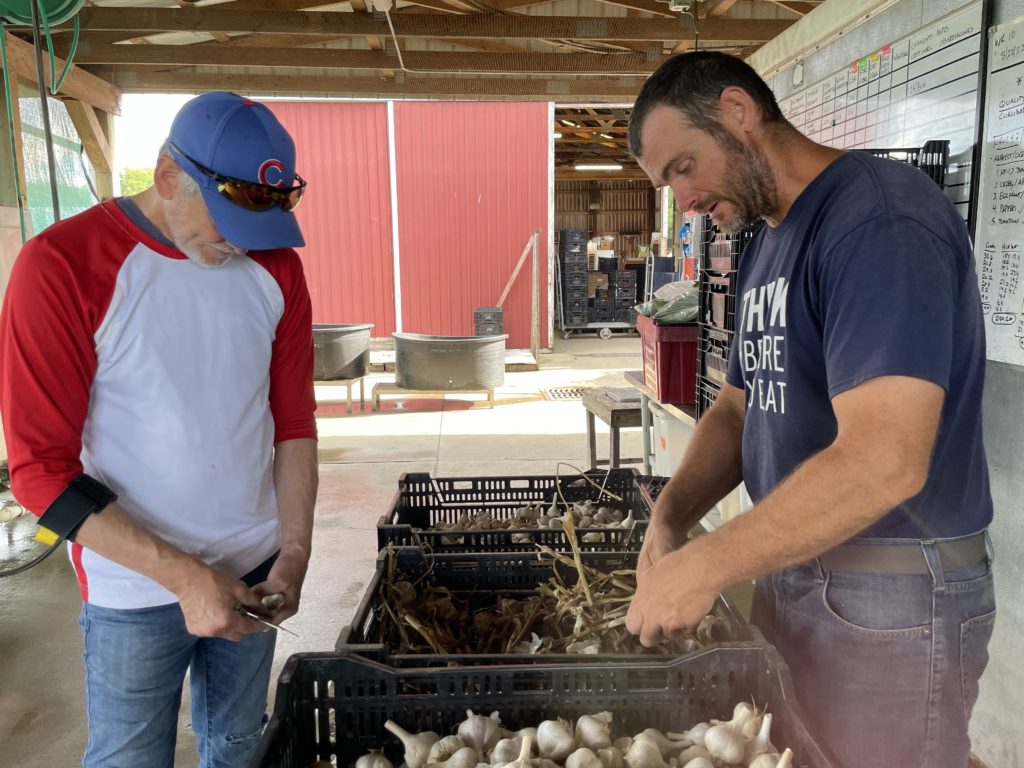
We could use volunteers to help us process the garlic! Let us know if you can give us an hour or two. It’s pretty easy!
WEEK 11 ANNOUNCEMENTS
- We are looking for volunteers to help us clean/process the cured garlic! This is a pretty easy job. You work under the shade, snipping the stems off from the bulbs, then cleaning the top layer of skin off. We have 50 crates to get through, and each crate takes about 30 minutes. If we can find 10 people each week to work on this for the next two weeks, we will knock this out fast! Let us know if you are willing to come out for an hour or two and work on this for us!
- You can now pre-order Canning tomatoes (25 lb) from the farm via email. To place your pre-order, please drop a comment into the pinned post in our Facebook group, or email me. Tell me how many 25 lb. orders you want and what type (Roma or Globe), and what your pickup site is. I will do my best to fill those orders as soon as possible. You may have to wait 2 weeks before you get it. I’ll send out an email a few days before your pickup to let you know they are coming. .Payment is expected at the time of pickup.You can choose from these two tomato canner products:
- ROMA TOMATOES — you’ll get 25 lbs of these classic, oval-shaped, paste tomatoes. These are best used for sauce and salsa, since they have a lower water content. Price: $30
- GLOBE TOMATOES – you’ll get 25 lbs. of the classic round tomato. These are best used for canning whole tomatoes. This will be enough to can 7-8 quarts (or 16 pints) in your canner. Price: $30
3. FIELD TO TABLE DINNER — reserve now! You can now place your reservations for our final Field to Table dinner, to be held on Sept. 10. You may arrive at 5 PM to stroll our fields and take one of our 3 scheduled tractor hay ride tours. Dinner begins at 6 PM. Dress comfortably — it may get a bit chilly when the sun sets. This event will be catered by Cork and Knife Provisions (Chef Joseph Jacobsen –formerly of Degage Jazz Cafe), and will be held outside in the middle of our field. It will be a sit-down meal, served by a wait staff. The menu include 5 courses. Fizzitap Vintage Beverage Truck will also be in attendance, ready to serve you 2 fun mocktails from 5-8 PM at no extra charge. No alcohol will be served. However, you are encouraged to bring your own beer or wine. Tickets are $75/person. To place your reservation, head to this link to pre-pay. You may at that time also request a vegetarian option if needed. Tickets are first-come, first-serve. You are welcome to invite friends who are not in the CSA.
To place your reservation, head to this link to pre-pay.
4. You can order additional items from the Shared Legacy Farms online store. Our store link is super easy to remember: www.sharedlegacyfarms.com/store. Just be sure to select the right pickup site that coincides with your pickup location. If the pickup option is greyed out or not available, it means you missed the window to order. You need to place your order 36 hours before your site. We harvest the product on Monday and Wednesday mornings — early. This week, the store will have: sweet corn, bulk sweet corn, cutting celery herb, parsley, celery, “all-star mix” kale, heirloom tomato packs, swiss chard, broccoli greens, sweet banana peppers, bell peppers, golden beets, candy stripe beets, jalapenos, Shishito peppers, sweet banana peppers, mini snack peppers (red) by the pint, red onions, dino kale, globe tomatoes, fresno chili peppers, zestar apples, ground cherries, a few tomatillos, Gala apples, large watermelons (red, orange, or yellow), cherry tomatoes by the pint, local maple syrup.

This pizza was made by the famous CSA foodie in our group, Bob Seaney
WEEK 11 CSA RECIPES
Members: You can download these recipes as a PDF. These recipes are designed to inspire you to use your box this week! Please check inside our private Facebook group to find your fellow members sharing ideas for what to make with their box! Share a photo and you might be featured in next week’s newsletter!
Simple Almond Chicken, Chickpea and Eggplant Curry
Flourless Eggplant Pizza
Bell Pepper Egg in a Hole
Marinated Roasted Peppers
Italian Peppers and Onions
Braised Tomatoes with Burrata
Skillet Dinner with Broccoli Leaves
Broccoli Leaves with Bacon Grease
Sweet Broccoli Leaf Smoothie
Mediterranean Couscous Salad
Tomato-Yogurt Dip with Baked Pita Chips
Pickled Peach Salad
Canary Melon Salad with Halloumi
